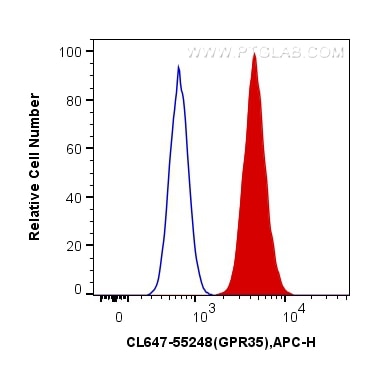Tested Applications
| Positive FC (Intra) detected in | A549 cells |
Recommended dilution
| Application | Dilution |
|---|---|
| Flow Cytometry (FC) (INTRA) | FC (INTRA) : 0.40 ug per 10^6 cells in a 100 µl suspension |
| It is recommended that this reagent should be titrated in each testing system to obtain optimal results. | |
| Sample-dependent, Check data in validation data gallery. | |
Product Information
CL647-55248 targets GPR35 in FC (Intra) applications and shows reactivity with human samples.
| Tested Reactivity | human |
| Host / Isotype | Rabbit / IgG |
| Class | Polyclonal |
| Type | Antibody |
| Immunogen |
Peptide Predict reactive species |
| Full Name | G protein-coupled receptor 35 |
| Calculated Molecular Weight | 34 kDa |
| GenBank Accession Number | NM_005301 |
| Gene Symbol | GPR35 |
| Gene ID (NCBI) | 2859 |
| RRID | AB_2883650 |
| Conjugate | CoraLite® Plus 647 Fluorescent Dye |
| Excitation/Emission Maxima Wavelengths | 654 nm / 674 nm |
| Form | Liquid |
| Purification Method | Antigen affinity purification |
| UNIPROT ID | Q9HC97 |
| Storage Buffer | PBS with 50% glycerol, 0.05% Proclin300, 0.5% BSA, pH 7.3. |
| Storage Conditions | Store at -20°C. Avoid exposure to light. Stable for one year after shipment. Aliquoting is unnecessary for -20oC storage. |
Background Information
GPR35, also named as KYNA receptor, belongs to the G-protein coupled receptor 1 family. GPR35 acts as a receptor for kynurenic acid, an intermediate in the tryptophan metabolic pathway. The activity of GPR35 is mediated by G-proteins that elicit calcium mobilization and inositol phosphate production through G(qi/o) proteins (PMID:16754668). This antibody is specific to GPR35.
Protocols
| Product Specific Protocols | |
|---|---|
| FC protocol for CL Plus 647 GPR35 antibody CL647-55248 | Download protocol |
| Standard Protocols | |
|---|---|
| Click here to view our Standard Protocols |




